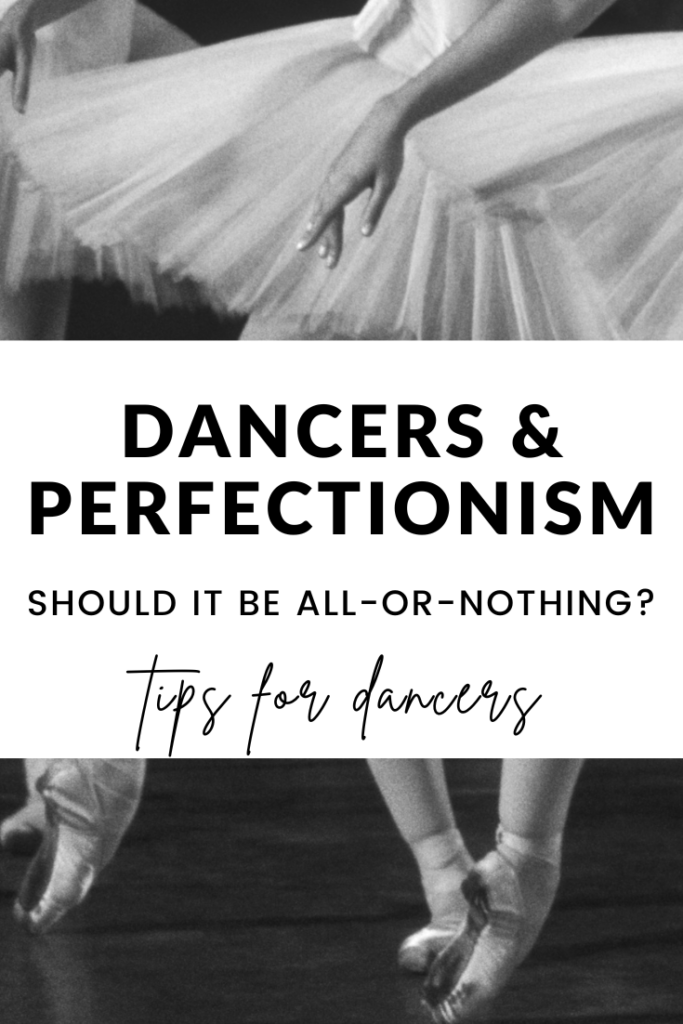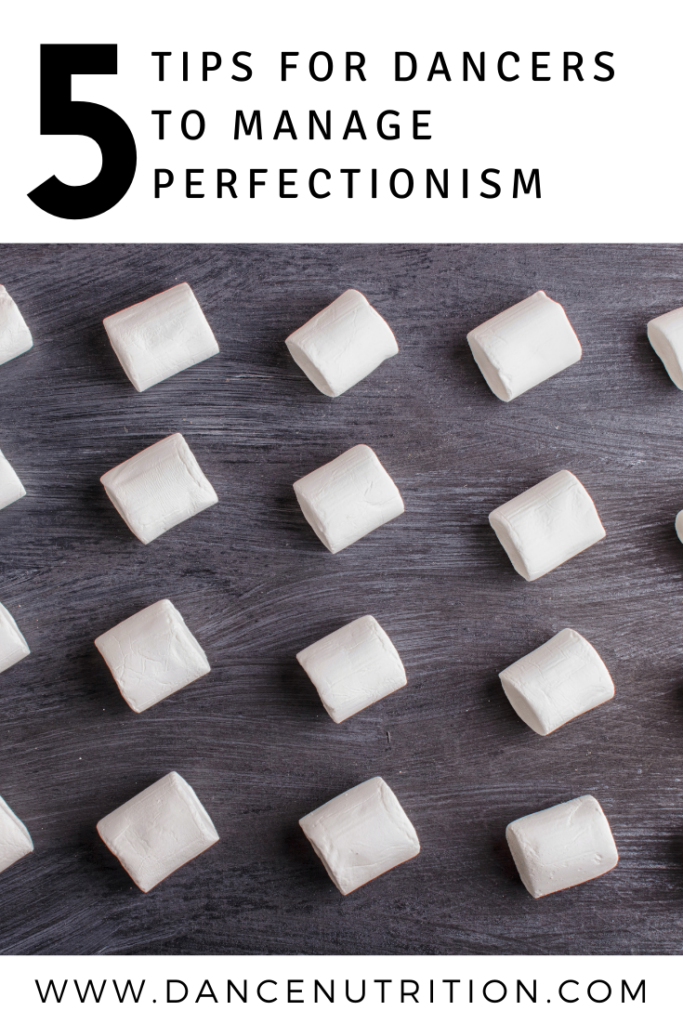With many [unattainable] food and body ideals at the forefront of the industry, dancers are especially vulnerable to perfectionistic behaviors that can limit performance potential. High expectations and striving to perfect the imperfect create an environment prone to obsessions and comparisons. Perfectionism and an all-or-nothing mindset can be a formidable opponent for dancers, but it’s not insurmountable.
What is perfectionism?
Perfectionism is a personality trait that is broadly defined in two parts. First is the act of setting excessively high standards of performance. Perfectionists are known to exhibit a high degree of determination, and for some, a desire for structure, planning, and organization— traits that might be misunderstood as motivators for dancers: if I strive to perfect my technique, I’ll succeed. However, these standards are arguably unrealistic and can set the stage for burnout.
In addition to this, the perfectionist pursuit often occurs in conjunction with self-limiting characteristics like self-criticism, rumination, worry over making mistakes, self-doubt, and guilt. As previously discussed, many dancers mistake self-discipline as a prerequisite for success in the studio. However, an all-or-nothing mindset can be both mentally and physically exhausting, hindering progress and stripping the joy away from dance.
Tackling The Dancer’s All-Or-Nothing Mindset
As a recovering perfectionist myself, I’ve learned to utilize a proactive effort to shift superhuman ideals into sustainable (and realistic) goals. For this blog post, I’ve teamed up with licensed psychotherapist Amy Pope-Lantham of Coastal Beaches Therapy, a former classically-trained dancer, to explore five strategies that can help dancers tackle the all-or-nothing mindset and find a healthier balance in their dance journey.
#1: Identify Perfectionist Potential
For dancers, perfectionism often stems in the studio and further develops with the reinforcement of such behaviors from teachers. “Let’s say, for example, you observe another dancer being rewarded for weight loss. Perhaps they’re cast as the lead role or they’re receiving special attention in class. You might believe that a low body weight is the standard that you must uphold,” Amy explains. “Such instances are not only fictitious but also likely to be impractical for you… ask yourself if any of these sound familiar:”
- The harder I work, the better I will do.
- Restricting my food intake will put me ahead.
- Giving up any outside distractions from dance will allow me to succeed.
- The more I rehearse, the better I will be when compared to my peers.
- I’ll never be happy unless I succeed.
- If I break my perfect diet, I’m a failure.
- If I eat one cookie, I may as well eat ten cookies.
- I always need to look perfect in front of others.
- If I don’t get the lead role, I don’t deserve to be in this school.
- My pirouettes are never good enough.
Amy suggests examining where those thoughts come about. Where does your perfectionism reside? Here are a few common sources:
- Performance at school and/or at work
- In the dance studio
- Relationships, friendships, and family life
- Relationships with food and eating habits
- Fun and recreation
- Neatness and aesthetics
- Organization and ordering
- Writing or speaking
- Physical Appearance
- Health
#2: Unravel The Triggers
Once you’ve begun identifying the potential for perfectionism, consider if your current behaviors are evidence for intervention. Amy offers examples to consider, including:
- Avoidance of situations that might test your performance (practicing in front of others).
- Procrastination (waiting until you are the last dancer in line to do turns across the studio)
- Goal achievement behaviors (over-preparing for turns)
- Reassurance seeking (seeking reassurance and specific feedback from the teacher)
Fact-checking is a helpful tool in unraveling an all-or-nothing mindset. “It’s not a surprise that dancers hold themselves to high standards, often feeding into self-criticism,” suggests Amy. Here are a handful of reflections to start:
- What facts and experiences support what I believe to be true?
- Have I been through this in a way that proves it to be true?
- If my best friend was thinking the same thing, what would I say to them?
- Five years from now, will I think about it any differently?
#3: Prioritize The Process
One of the key identifiers of perfectionism is a tendency to focus on lofty goals, rather than the journey to get there. For dancers, this blurs the process— hours spent in the studio become minimized and your endless effort feels chronically insufficient. Setting unrealistic goals can contribute to the all-or-nothing mindset.
Instead, dancers must learn to appreciate incremental progress. Start by breaking down your goals into manageable steps. While it’s important to dream big, goals should be achievable. In regards to food, striving for a “perfect” diet can open doors to disordered eating. Building a supportive relationship with food is encouraged.
#4: Embrace Variety and Flexibility
When working with dancers, challenging food fears is equally as important as challenging food obsessions. As Amy suggests, “challenge your thoughts and how you interpret them.” This might involve exposure work— new foods, larger portions, eating after a specific window of time, ordering take-out, and eating foods with sauces are just examples. “Perfectionism helps to create safety behaviors (ie. measuring ingredients in a meal, counting calories, and eating at specific times). In these situations, give yourself permission to not have the tools.” Can you challenge yourself to bake or cook a specific recipe without the specific measurements?
In regard to dancing, diversify your training. Explore different dance styles, techniques, and choreographies. This variety not only keeps your practice exciting but also prevents burnout by giving you a break from the intensity of your primary focus. Amy offers additional tasks to help challenge perfectionistic behavior:
- Take a workout class that you have never tried before.
- Work out in the company of other people.
- Say something incorrect when asked.
- Spill a drink.
- Prepare a new lunch using different ingredients.
- Ditch your measuring utensils.
- With permission from your school or company, change up your hairstyle or choose another leotard.
#5: Welcome Discomfort Through Compassion
Practicing self-compassion is essential. Understand that making mistakes is a natural part of the learning process. Treat yourself with kindness and empathy, just as you would a fellow dancer. Remember, dance is not about perfection; it’s about the process— the joy of movement, creation, and self-expression.
Allowing time for life’s unpredictable circumstances is important— accepting the reality that perfection doesn’t exist and that progress is in itself the ultimate goal. But this is often easier said than done. Dancers are encouraged to work alongside licensed professionals— a team that involves a mental health professional and a Registered Dietitian Nutritionist. By doing this, you’ll build coping skills to navigate the discomfort.




